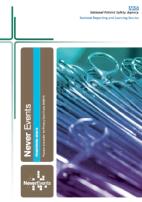NHS Patient Safety Timeline
This is a timeline of historical developments relating to the management of patient harm and safety in the NHS. It has been designed to be of use to academics, researchers, policymakers, campaigners, and others with a broad interest in patient safety.
The timeline is shared under a Creative Commons license, meaning that the timeline is free to be used or adapted in research and teaching elsewhere, with attribution to Dr Christopher SirrsLink opens in a new window/the Hazardous Hospitals project.
When did patient safety in the NHS begin?
Patient safety became a major object of healthcare policy in Britain with the publication of the report An Organisation with a Memory by the Department of Health in 2000. However, patient safety has a very long prehistory, and various elements of patient safety, such as the need to report incidents in hospitals, or learn from patient deaths, have long been recognised. The following timeline explores key developments in patient safety since 2000, as well as events and developments which contributed to evolving understanding of patient harm in the NHS since 1948.
| Year | UK patient safety events | Other events | |
|---|---|---|---|
| 1948 | Establishment of the NHS. | ||
| 1952 | Establishment of national Confidential Enquiry into Maternal DeathsLink opens in a new window | ||
| 1955 | First guidance from the Ministry of Health to NHS hospitals on the reporting of accidents and untoward occurrences (HM(55)66). |  |
|
| 1960 | Guidance from the Ministry of Health on 'Prevention of Harm to Patients Resulting from Physical or Mental Disability of Hospital Medical or Dental Staff' (HM(60)45). |  |
|
| 1961 | Joint Memorandum by the Medical Defence Union, Royal College of Nursing, and National Council of Nursing, 'Safeguards against wrong operations'. |  |
|
| 1963 | Joint Memorandum by the Medical Defence Union, Royal College of Nursing, and National Council of Nurses, 'Safeguards against failure to remove swabs, etc., from patients'. |  |
|
| 1966 | First guidance to NHS hospitals from Ministry of Health on the handling of patient complaints, containing provisions for the holding of inquiries. (HM(66)15). |  |
|
| 1967 | The campaigner Barbara Robb’s Sans Everything: A Case to AnswerLink opens in a new window draws attention to the care of the elderly on long-stay hospital wards in psychiatric hospitals. While several of her recommendations, such as a hospital inspectorate, were subsequently adopted by the government following the Ely Scandal, her allegations were dismissed, and Robb was discredited by the Minister of Health, Kenneth Robinson. | ||
| 1968 | Ministry of Health report Allegations Concerning the Care of Elderly Patients in Certain Hospitals (Cmnd. 3687). | 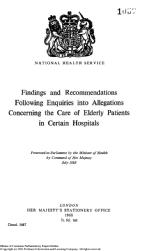 |
Creation of Department of Health and Social Security (DHSS)Link opens in a new window. |
| 1969 | Ely Hospital report: Report of the Committee of Inquiry into Allegations of Ill – Treatment of Patients and other irregularities at the Ely Hospital, Cardiff (Cmnd. 3975). | 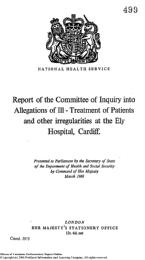 |
|
| 1970 | Establishment of the Hospital Advisory ServiceLink opens in a new window to inspect hospitals and make recommendations. However, the Service is not empowered to investigate individual complaints, or intervene in matters of clinical judgement. | ||
| 1972 |
Guidance to hospitals on the prevention of surgical accidents (HM(72)37) |
 |
|
| 1973 |
Guidance to hospitals on the reporting of accidents associated with defects in medicinal products, supplies and equipment (HM(73)9). |
Report of the Davies Committee into hospital complaints procedures (Report of the Committee on Hospital Complaint Procedure). Establishment of the Health Service Commissioner (Ombudsman). Patient complaints can be referred to the Ombudsman, but it is not empowered to investigate clinical complaints, or the actions of GPs. |
|
| 1974 | NHS reorganisation: creation of Regional Health Authorities (RHAs), Area Health Authorities (AHAs), and district management teams Establishment of Community Health Councils (CHCs), which act as the voice of patients in the NHS, but cannot deal with complaints arising from clinical procedures. |
||
| 1975 | Merrison Committee report into the regulation of the medical profession. | ||
| 1976 | Hospital Advisory Service expanded to include community health services, becoming NHS Health Advisory Service. | ||
| 1978 | Report of the Pearson Commission recommends that the experiences of New Zealand and Sweden in relation to the institution of no-fault compensation for medical injuries should be examined. | ||
| 1980 | Airing of BBC ‘Play for Today’ Minor Complications, by the playwright Peter Ransley, focusing on medical injuries. | 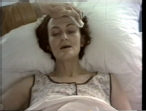 |
Black Report on health inequalities published, but buried.Link opens in a new window |
| 1981 | First guidance to NHS hospitals on the handling of clinical complaints (e.g. relating to patient safety incidents). | ||
| 1982 | Establishment of Action for the Victims of Medical Accidents (AvMA), later Action Against Medical Accidents | NHS reforms: abolition of Area Health Authorities (AHAs) and creation of District Health Authorities (DHAs). | |
| 1983 | Griffths Report: NHS general management introduced. | ||
| 1984 | Establishment of Anesthesia Patient Safety Foundation (USA) | ||
| 1985 | Avoidable Mishaps in Medicine study at UCLLink opens in a new window. |
Hospital Complaints Procedure Act requires that all NHS hospitals have a complaints procedure in place. Establishment of NHS Management Executive. |
|
| 1986 | Establishment of Datix, developer of incident reporting and risk management software | ||
| 1987 | White paper, Promoting Better Health: The Government’s Programme for Improving Primary Health Care | ||
| 1988 | Establishment of National Confidential Enquiry into Perioperative Deaths (NCEPOD) (later National Confidential Enquiry into Patient Outcomes and Death).Link opens in a new window | Department of Health and Social Security (DHSS) splits into Department of Health and Department of Social Security. | |
| 1989 | Brighton Health Authority initiates pilot clinical risk management programme. First AVMA annual conference held in Harrogate. |
White paper, Working for Patients formalises process of clinical audit in the NHS | |
| 1990 | Crown indemnity for medical negligence introduced, placing the onus of financial responsibility for managing clinical risks onto regional and district health authorities and new NHS trusts (as opposed to medical insurers). Launch of International Journal of Risk and Safety in Medicine Launch of AVMA Medical and Legal Journal |
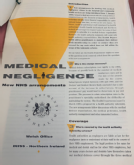 |
National Health Service and Community Care Act |
| 1991 | Implementation of NHS reforms. Introduction of internal market and GP fundholding. Establishment of NHS Trusts with boards composed of Executive and Non-Executive Directors. Establishment of Institute for Healthcare Improvement (USA) |
||
| 1992 | Launch of journal Quality in Health Care Establishment of Confidential Enquiry into Stillbirths and Deaths in Infancy (CESDI) |
Session on ‘Human Error in Medicine’ at American Association for Advancement of Science meeting | |
| 1993 |
Report of Audit Commission finding continuing problems with NHS complaints procedure. Publication of Risk Management in the NHS by the NHS Management Executive. This manual, aimed at managers within the NHS, covered direct and indirect risks to patient care, health and safety risks, and organisational risks such as data security. Sir Duncan Nichol, the Chief Executive of the NHS Management Executive, warned health care providers that 'risk management ... is no longer an optional extra'. Amongst its many recommendations was the need for NHS providers to establish standardised incident reporting systems, and the need for training of staff in risk management. |
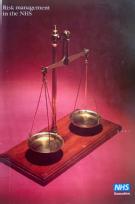 |
|
| 1994 | Royal Society of Medicine conference on clinical risk management.Link opens in a new window Establishment of Association of Litigation and Risk Management (ALARM)Link opens in a new window |
NHS Management Executive renamed NHS Executive. | |
| 1995 | Medical (Professional Performance) Act empowers the General Medical Council to consider the clinical performance of doctors. Establishment of NHS Litigation Authority (now NHS ResolutionLink opens in a new window). Establishment of Clinical Negligence Scheme for Trusts (CNST) whereby Trusts self-insure by pooling financial risks for clinical negligence claims. Establishment of Clinical Risk Unit at UCLLink opens in a new window. Launch of journal Clinical Risk, incorporating AVMA Medical and Legal Journal |
||
| 1996 |
Health Service Commissioner (Ombudsman) required to consider clinical complaints and actions of GPs. Regional Health Authorities (RHAs) abolished, replaced by regional offices of the NHS Executive; District Health Authorities replaced by Health Authorities. |
||
| 1997 | Department of Health white paper The New NHS: Modern. Dependable, introducing concept of clinical governance. Establishment of National Patient Safety Foundation (USA) |
||
| 1998 |
NHS Trusts begin to publish death rates from surgery (October) Opening of the public inquiry into the events at Bristol Royal Infirmary (Kennedy Inquiry) |
Department of Health report, A First Class Service: Quality in the New NHS. Public Interest Disclosure Act 1998. |
|
| 1999 |
Health Select Committee considers the handling of adverse incidents and occurrences in the NHS. Department of Health commissions Expert Committee on Learning from Experience under the chairmanship of Chief Medical Officer, Liam Donaldson. |
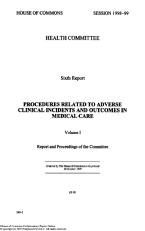 |
US Institute of Medicine report To Err is Human: Building a Safer Health SystemLink opens in a new window. Health Act: Creation of Primacy Care Trusts (PCTs); statutory duty on PCTs, Health Authorities and NHS Trusts to monitor and improve quality; Commission for Health Improvement. |
| 2000 | Department of Health report, An Organisation With A MemoryLink opens in a new window estimates that 850,000 patients (around 1 in 10) admitted to NHS hospitals encounter an adverse health event. However, these figures are very broad extrapolations based on previous studies in the US, Australia, and UK. |  |
The NHS Plan: A Plan for Investment. A Plan for ReformLink opens in a new window outlines the Labour Government’s reform plans for the NHS. The Government commits to sending the Commission for Health Improvement into Trusts where there are serious concerns about patient safety. It further commits to the establishment of a mandatory reporting system for adverse health events. |
| 2001 |
Department of Health report Building a Safer NHS for Patients: Implementing An Organisation With A MemoryLink opens in a new window sets out the steps taken by the government to fulfil the recommendations of An Organisation with a Memory. This includes the rationale behind the creation of the National Patient Safety Agency (NPSA) and the new, mandatory National Reporting and Learning System (NRLS). Establishment of National Patient Safety AgencyLink opens in a new window (NPSA). |
 |
|
| 2002 |
Journal Quality in Health Care becomes Quality and Safety in Health Care Strategic Executive Information System (STEIS) made available to all NHS organisations. The system is used to capture managerial information, for example daily situation reports (SITREPs) and serious adverse incidents. |
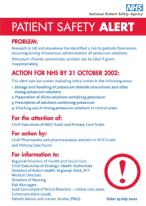 |
National Health Service Reform and Health Care Professionals Act; renaming and replacement of Health Authorities with Strategic Health Authorities (initially 28, later reduced to 10); abolition of NHS Executive and its regional offices. Establishment of Commission for Patient and Public Involvement in Health Establishment of Council for Healthcare Regulatory Excellence (CHRE) Establishment of Patient Advisory and Liaison Services (PALS) |
| 2003 |
Consultation paper Making Amends, setting out proposals to reform system of clinical governance and recommending a legal duty of candour. Creation of Council for Healthcare Regulatory Excellence (CHRE).
|
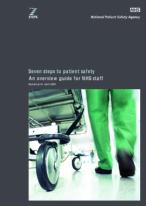 |
Abolition of Community Health Councils (CHCs) |
| 2004 |
Health Foundation launches the Safer Patients InitiativeLink opens in a new window (ran until 2008). |
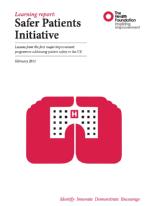 |
Health and Social Care (Community Health and Standards) Act. Establishment of Healthcare Commission, legally known as Commission for Healthcare Audit and Inspection (CHAI). The CHAI incorporates the functions of the previous Commission for Health Improvement. |
| 2005 |
National Audit Office report: A Safer Place for Patients: Leaning to Improve Patient SafetyLink opens in a new window NPSA alert and guidance on Being Open: Communicating Patient Safety Incidents with Patients and their Carers |
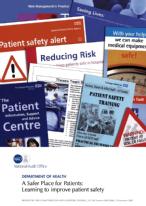 |
Establishment of NHS Institute for Innovation and ImprovementLink opens in a new window. |
| 2006 | Department of Health report Safety First Creation of National Patient Safety Forum Department of Health report Good Doctors, Safer Patients NHS Redress ActLink opens in a new window passed by Labour government, providing mechanisms for financial redress in lieu of litigation, but subsequently left to languish on statute book |
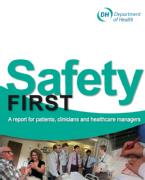 |
|
| 2007 |
Publication of Healthcare Risk Assessment Made Easy by NPSA Concerns raised about mortality rate at Mid Staffordshire General Hospitals NHS Trust |
 |
|
| 2008 |
Publication of Lord Darzi’s review, High Quality Care for AllLink opens in a new window. Formation of Safe Anaesthesia Liaison GroupLink opens in a new window. A collaboration between the Royal College of Anaesthetists, Association of Anaesthetists and NHS England |
 |
|
| 2009 |
Establishment of the Care Quality Commission (CQC)Link opens in a new window, replacing the Healthcare Commission. WHO Surgical Safety ChecklistLink opens in a new window mandated for use in NHS NPSA revised guidance on Being Open
NPSA publishes first iteration of its Never Events Policy Framework. 'Never events' are defined as 'serious, largely preventable patient safety incidents that should not occur if the available preventative measures have been implemented.' Initially, eight never events are listed including wrong-site surgery and retained instrument post-operation. The term 'Never Event' was first introduced in 2001 by Ken Kizer, the former CEO of the National Quality Forum in the USA. |
||
| 2010 |
Publication of initial Francis Report into healthcare failures at Mid Staffordshire NHS Foundation Trust. Public inquiry into events at Mid Staffordshire NHS Foundation Trust announced by Secretary of State for Health, Andrew Lansley. Again chaired by Robert Francis QC (Final report published in 2013). NPSA publishes National Framework for Reporting and Learning from Serious Incidents Requiring Investigation (the Serious Incident Framework). The SIF was revised by the NHS Commissioning Board in 2013, and again by NHS England in 2015. Commencement of National Venous Thromboembolism (VTE) Prevention Programme, mandating risk assessment for VTE for all adult inpatients to acute hospitals in England. |
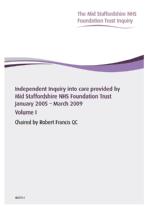 |
|
| 2011 | Journal Quality and Safety in Health Care becomes BMJ Quality and Safety NHS Wales launches NHS redress scheme (Putting Things Right) |
||
| 2012 |
NPSA. Functions transferred to NHS England. CHRE becomes Professional Standards Authority for Health and Social Care (PSA). |
Health and Social Care Act: NHS reorganisation. | |
| 2013 |
Full Francis Report on healthcare failures at Mid Staffordshire NHS Foundation TrustLink opens in a new window. |
 |
Establishment of HealthwatchLink opens in a new window and NHS EnglandLink opens in a new window Replacement of NHS Institute with NHS Improving Quality. |
| 2014 |
Establishment of Patient Safety Collaboratives. |
||
| 2015 |
The Report of the Morecambe Bay Investigation (Kirkup ReportLink opens in a new window). Publication of the Freedom to Speak Up Review by Robert Francis QCLink opens in a new window Public Administration Select Committee report on clinical incidents in the NHS. Recommendation that a new independent patient safety investigation body should be established. Health and Social Care (Safety and Quality) ActLink opens in a new window |
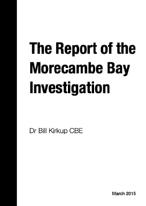 |
|
| 2016 |
Establishment of NHS ImprovementLink opens in a new window, merging functions of Monitor and NHS Trust Development Agency. Creation of the National Guardian's OfficeLink opens in a new window, and Freedom to Speak Up Guardians in NHS. |
||
| 2017 |
Establishment of Healthcare Safety Investigation Branch (HSIB)Link opens in a new window. Publication of National Guidance on Learning frrom DeathsLink opens in a new window |
 |
|
| 2018 |
Report of Gosport Independent Panel into mortality at Gosport War Memorial HospitalLink opens in a new window. The report showed that concerns had been raised by nurses as early as 1991 about the inappropriate prescription and administration of drugs such as diamorphine, and that the lives of over 450 people had been shortened between 1987 and 2001. However, the scandal only came to public attention following the death of Gladys Richards in 1998, who had been admitted following a hip operation. Publication of A Just Culture GuideLink opens in a new window by NHSEI |
 |
Department of Health becomes Department of Health and Social Care (DHSC). |
| 2019 | Publication of NHS Patient Safety Strategy by NHS England and NHS Improvement: Safer Culture, Safer Systems, Safer Patients.Link opens in a new window | 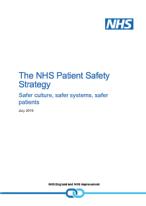 |
NHS England and NHS Improvement merge. Creation of ministerial role for patient safety(along with mental health and suicide prevention): Nadine Dorries MPLink opens in a new window originally appointed as Parliamentary Under-Secretary of State (now Minister). |
| 2020 |
Report of the Independent Inquiry into the Issues Raised by PatersonLink opens in a new window Publication of introductory version of Patient Safety Incident Response Framework (PSIRF)Link opens in a new window by NHSEI |
 |
|
| 2021 | Rollout of the Learn From Patient Safety Events (LFPSE) serviceLink opens in a new window, replacement of the National Reporting and Learning System (NRLS). The new service promises, amongst other things, to cut through the 'information overload' of the previous incident management system by leveraging new technology, such as machine learning, to create more useful outputs, and making it easier for NHS staff to upload, access and analyse patient safety event data. | ||
| 2022 |
Appointment of the first Patient Safety Commissioner, an outcome of the Cumberledge Report (2020)Link opens in a new window. 'The independent commissioner will act as a champion for patients and lead a drive to improve the safety of medicines and medical devices' – Department of Health and Social Care. National State of Patient Safety Report 2022, by Institute of Global Health Innovation at Imperial College London, commissioned by the charity Patient Safety WatchLink opens in a new window. The report draws attention to improvement in various indicators of patient safety at a national level in England, but also ongoing areas of concern, notably around maternity services, staff shortages, access to care, and waiting lists. The report recommends that the breadth of patient safety data needs to increase; that the accuracy of key patient safety measures needs to improve; the need for an urgent workforce plan for the NHS and social care; that Integrated Care Systems should play a central role in monitoring patient safety; and that progress in the safety of maternity services needs to accelerate. |
 |

Patient Safety Timeline by Dr Christopher Sirrs is licensed under a Creative Commons Attribution-NonCommercial-ShareAlike 4.0 International License.



